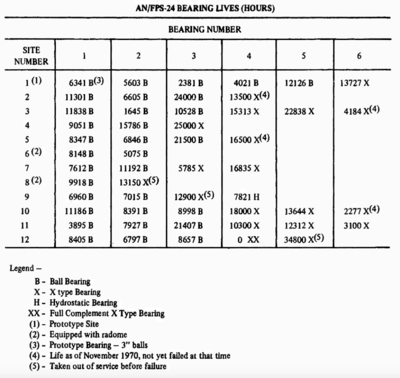FPS-24: Difference between revisions
John Stanton (talk | contribs) No edit summary |
John Stanton (talk | contribs) No edit summary |
||
| Line 17: | Line 17: | ||
RADC-TR-71-81 Technical Report December 1971, Bearing Improvement Program For Large Rolling Element Bearings, [http://www.dtic.mil/dtic/tr/fulltext/u2/891286.pdf Pdf]</blockquote> | RADC-TR-71-81 Technical Report December 1971, Bearing Improvement Program For Large Rolling Element Bearings, [http://www.dtic.mil/dtic/tr/fulltext/u2/891286.pdf Pdf]</blockquote> | ||
The cure for the bearing problem was the development of a hydrostatic bearing for the AN/FPS-24 by Goodyear Aerospace Corp. The prototype was tested at Oakdale Air Force Station. Test terminated after 7821 hours with a catastrophic failure caused by human error. That bearing is shown on the chart above in line 9.That FPS-24 was not supplied with another bearing and it shut down in 1969. No other sites had received the the hydrostatic bearings as of the date of this report (1970). | |||
{{Clr}} | {{Clr}} | ||
== Current Status == | == Current Status == | ||
| Line 50: | Line 52: | ||
| PRF || || | | PRF || || | ||
|- | |- | ||
| Pulse Width || | | Pulse Width || 20 us || | ||
|- | |- | ||
| Power || 7.5 mw max<br>5 mw normal|| | | Power || 7.5 mw max<br>5 mw normal|| | ||
Revision as of 18:59, 29 September 2016
|
FPS-24 Long range search Radar Set - A Long range frequency diversity search Radar set designed for select SAGE System radar sites built by General Electric. Twelve units were built for the United States Air Force between 1958 and 1962 by General Electric.
These radar sets, like the FPS-35, were installed in and on five story towers that were each capped with a 70 to 80 ton rotating antenna. Two types of towers were used, the most common was a five story concrete tower that rose 84' 6" high with a 60' 3" square footprint. This configuration was used in eight of the FPS-24 installations with the other four installations using steel framed towers. The rotating antennas were very large and only two were covered with a radome, Mount Hebo Air Force Station and Cottonwood Air Force Station.
 The initial installations of the FPS-24 revealed many problems that caused a delay in operational status. The problems were resolved and the radar was operational in 1962. The antenna system provided another set of operational problems mostly due to failures of the bearing that the 85.5-ton antenna rotated upon. Catastrophic bearing failures sometimes caused secondary damage to the support towers, sails, and feed horns. Some sites were actually closed due to catastrophic failure of the antenna system and others were forced install other search radar sets when the damage could not be repaired. At Mount Hebo Air Force Station fears that the high winds would dammage the FPS-24 antenna led to three attempts to enclose it in a radome. All three radomes were destroyed by the high winds and the last radome failure also damaged the antenna sail. The FPS-24 was removed and replaced with a FPS-27.
The cure for the bearing problem was the development of a hydrostatic bearing for the AN/FPS-24 by Goodyear Aerospace Corp. The prototype was tested at Oakdale Air Force Station. Test terminated after 7821 hours with a catastrophic failure caused by human error. That bearing is shown on the chart above in line 9.That FPS-24 was not supplied with another bearing and it shut down in 1969. No other sites had received the the hydrostatic bearings as of the date of this report (1970).
Current StatusAll of the radar sets have now been dismantled and removed from the buildings and although many of the towers remain there are no antennas still installed.
FPS-24 Search Radar
|
|||||||||||||||||||||||||||||||||||||||||||||||||||||||||||||||||||||||||||||||||||||||||||||||||||||||||||||||||||||||||||||||||||||||||||||||||||||||||||||||||||||||||||||||||||||||||||||||||||||||||||||||||||||||||||||||
